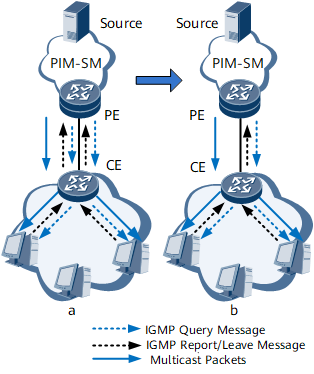Configuring IGMP On-Demand
Internet Group Management Protocol (IGMP) on-demand helps to maintain IGMP group memberships and frees a multicast device and its connected access device from exchanging a large number of packets.
Usage Scenario
On the network segment a shown in Figure 1, if IGMP on-demand is not enabled on the PE, the PE sends a large number of IGMP Query messages to the CE, and the CE sends a large number of Report and Leave messages to the PE. As a result, lots of PE and CE resources are consumed.
On the network segment b shown in Figure 1, after IGMP on-demand is enabled on the PE, the PE sends only one general query message to the CE. After receiving the general query message from the PE, the CE sends the collected Join and Leave status of IGMP groups to the PE. The CE sends a Report or Leave message for a group to the PE only when the Join or Leave status of the group changes. To be specific, the CE sends an IGMP Report message for a multicast group to the PE only when the first user joins the multicast group and sends a Leave message only when the last user leaves the multicast group.

The multicast device interface connected to the access device sends only one IGMP general query message to the access device.
The records about dynamically joined IGMP groups on the multicast device interface connected to the access device do not time out.
The multicast device interface connected to the access device directly deletes the entry for a group only after the multicast device interface receives an IGMP Leave message for the group.
Pre-configuration Tasks
Before configuring IGMP on-demand, complete the following tasks:
Configure a unicast routing protocol to ensure that unicast routes are reachable.
Procedure
- Run system-view
The system view is displayed.
- Run interface interface-type interface-number
The interface view is displayed.
- Run igmp on-demand
The IGMP group that an interface dynamically joins is configured not to time out.
- Run commit
The configuration is committed.
Checking the Configurations
Run the display igmp interface command to check IGMP on-demand configurations on an interface.
# Check IGMP on-demand configurations on interface Vlanif10.
<HUAWEI> display igmp interface Vlanif 10
